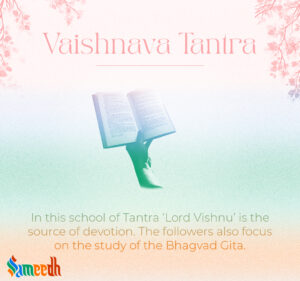Vaishnava Tantras are a branch of Hindu Tantra dedicated to the worship of Lord Vishnu, one of the principal deities in Hinduism, particularly in his various avatars (incarnations) such as Rama and Krishna. These Tantras, also known as Pancaratra Agamas, form the basis of the Vaishnava tradition and outline the theology, rituals, and spiritual practices associated with the worship of Vishnu and his forms.

Vaishnava Tantras comprise a collection of scriptures, primarily known as the Pancaratra Agamas, which provide detailed instructions on deity worship, temple construction, rituals, and spiritual practices related to Vaishnavism. Some of the important texts include the Narad Pancharatra, Ahirbudhnya Samhita, Vishnu Tantra, and Sanatkumar Samhita.
Vaishnava Tantras expound upon the philosophical foundations of Vaishnavism, emphasizing the supremacy of Lord Vishnu as the Supreme Being and the source of all creation, maintenance, and dissolution of the universe. They also elaborate on the concept of Bhakti (devotion) as the central path for spiritual realization, advocating loving surrender to Vishnu as the means to attain liberation (moksh).
Vaishnava Tantras teach the doctrine of avatar, which holds that Lord Vishnu incarnates on Earth in various forms (avatars) to uphold righteousness (dharm), protect the virtuous, and restore cosmic order. The most popular avatars include Ram, Krushna, Narasimha, and Vaman, among others.
Vaishnava Tantras prescribe a wide range of rituals and practices for the worship of Vishnu and his avatars, both in temples and at home. These may include daily puja (worship), recitation of mantras (such as the Vishnu Sahasranam), meditation, observance of festivals (such as Janmashtami and Ram Navami), and acts of charity and service.
Central to Vaishnava Tantras is the elaborate ritual worship (puja) of Vishnu in his various forms, often accompanied by his consort Lakshmi and other attendant deities. Devotees offer prayers, flowers, incense, food, and other offerings to express their love and devotion to the Lord and seek his blessings for spiritual upliftment and well-being.
Vaishnava Tantras provide detailed guidelines for the construction and consecration of Vishnu temples, outlining the architectural design, iconography, and rituals to be performed to ensure the sanctity and divine presence within the sacred space.
Over time, various Vaishnava lineages and traditions have emerged, each with its own interpretations of Vaishnava Tantras and practices. These include traditions such as Sri Vaishnavism (associated with Ramanuja), Gaudiya Vaishnavism (associated with Chaitanya Mahaprabhu), and Vallabhacharya’s Pushti Marg, among others.
Overall, Vaishnava Tantras serve as a comprehensive guide for devotees of Vishnu to deepen their spiritual connection, cultivate devotion, and attain spiritual liberation through the practice of Bhakti Yoga, or the yoga of devotion. Through rituals, prayers, and acts of service, followers of Vaishnava Tantra seek to realize the divine presence of Vishnu and experience his grace in their lives.
